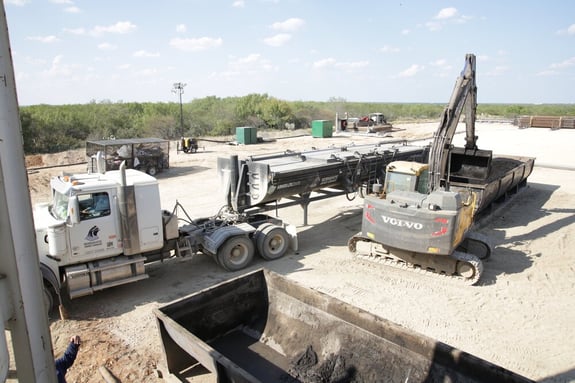 Safe and efficient disposal of cuttings and fluids is critical to the success of any drilling project. But before diving in to a discussion on the most popular disposal methods for drill cuttings, it is important to understand the value of an efficient solids control system. A properly designed and configured solids control system minimizes the overall volume of drill cuttings needing disposal. Formation geology, downhole temperature and pressure, and drilling mud are a few of the inputs to be considered prior to pairing shale shakers, degassers, desanders, and desilters to a solids control system. More comprehensive solids control systems information is available on the Guide to a Total Fluid Management Service.
Safe and efficient disposal of cuttings and fluids is critical to the success of any drilling project. But before diving in to a discussion on the most popular disposal methods for drill cuttings, it is important to understand the value of an efficient solids control system. A properly designed and configured solids control system minimizes the overall volume of drill cuttings needing disposal. Formation geology, downhole temperature and pressure, and drilling mud are a few of the inputs to be considered prior to pairing shale shakers, degassers, desanders, and desilters to a solids control system. More comprehensive solids control systems information is available on the Guide to a Total Fluid Management Service.
By tailoring the solids control systems to the well prior to drilling, operators can minimize total cuttings volume and the associated disposal costs. The most effective way to dispose of cuttings begins with having the least amount of cuttings that require disposal.
According to a recent Journal of Advanced Chemical Engineering article linked here, “The disposal and waste management cost is directly related to the volume of waste generated and as such, minimization as a waste management method must be a priority to other methods.”
What follows are the most popular disposal techniques:
- Landfarming: This process involves spreading drill cuttings on land and reincorporating into the soil of a licensed property. According to the Railroad Commission of Texas, to ensure appropriate incorporation of the waste into the soil and that no waste will migrate off of the approved disposal site, landfarming and land treatment permits typically require the waste to be mixed into the receiving soil via tilling, disking, or plowing. If the tilling, disking, or plowing of the waste into the receiving soil cannot be done at a proposed disposal site, that site is unsuitable for land-spreading and an alternative site where the tilling, disking, or plowing of the waste into the soil can be done should be proposed. The disposal process utilizes the physical, chemical and biological capabilities of the soil-plant system to control waste migration and to provide a safe means of disposal without impairing the potential of the land for future use. This disposal option is popular and economical.
- Injection Injection of cuttings into a permitted well or cavern, also known as reinjection, is another popular disposal solution for managing cuttings disposal, especially in remote areas. In this process, drill cuttings are removed from drilling fluid with the solids control system, separated from mud, ground to fine particles and mixed into a cuttings slurry. The slurry is then re-injected into a well or cavern. By returning drill cuttings to their origin, injection is considered an environmentally friendly, zero-discharge disposal solution.
- Biodegradation Biodegradation uses microorganisms to biologically degrade cuttings and mud into simpler components. The process utilizes a nitrogen source for bacterial growth, continual dilution and an odor suppressant. The mixture of cuttings/mud and bacteria must be frequently turned to introduce oxygen to the process. In 2011, Biotechnology Research International published Microbial Degradation of Petroleum Hydrocarbon Contaminants: An Overview. The authors concluded that microbial degradation can be considered as a key component in the cleanup strategy for petroleum hydrocarbon remediation. Currently, biodegradation is considered relatively slow and cannot process large volumes of cuttings.
- Solidification In this process, disposed cuttings and mud are mixed with a solidification agent such as clay, cement, fly ash and/or lime, to form a concrete-like solid, mechanically binding the cuttings. Solidification of drill cuttings at the wellsite reduces cuttings moisture content, improving handling and reduces transportation costs. The solid product can be disposed at an authorized disposal site or repurposed for uses such as road aggregate, engineered fill and construction material. This disposal method’s usage varies regionally.
- Incineration is another drill cuttings disposal method used far less frequently in comparison to other options. In this process, thermal systems are used to burn drill cuttings, typically offshore. Due to the resulting air emissions, safety concerns of the heat source, and high efficiency required, this is not a widely used disposal method.
The experts at Panther Fluids Management can help determine the best drill cuttings disposal method for your drilling program as well as the right solids control system, equipment and personnel. At Panther Fluids Management, our drilling fluid systems are backed by years of experience and have consistently lowered overall mud costs for clients. We consult with the operator to design the best fluid system for each well; including everything from discrete services like mud and screens to fluids engineering to complex closed-loop systems for solids control to haul-off and disposal. We understand the total fluids life cycle and can prepare for many contingencies based on well conditions. Contact Panther Fluids Management today for the latest in drilling fluids technology.

